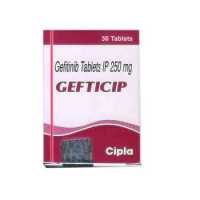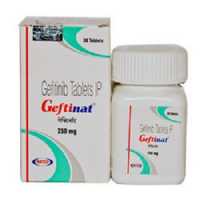Gefitinib, as a selective tyrosine kinase inhibitor of epidermal growth factor receptors, the expression of which is observed in many solid tumors, inhibits tumor growth, metastasis and angiogenesis, and accelerates apoptosis of tumor cells. Inhibits the growth of various lines of human tumor cells and increases the antitumor activity of chemotherapy drugs, radiation and hormone therapy.
Buy Gefitinib | price gefitinib India
-
 Gefticip Gefitinib 250mgIn Stock: много
Gefticip Gefitinib 250mgIn Stock: много
Gefitinib
Description of dosage form
Round biconvex tablets covered with a film shell from pink to pink with a brownish tint of color.
Pharmacological group
An antitumor agent, proteincontaining inhibitor.
Pharmacodynamics
Gefitinib, as a selective tyrosine kinase inhibitor of epidermal growth factor receptors, the expression of which is observed in many solid tumors, inhibits tumor growth, metastasis and angiogenesis, and accelerates apoptosis of tumor cells. Inhibits the growth of various lines of human tumor cells and increases the antitumor activity of chemotherapy drugs, radiation and hormone therapy.
Clinical evidence suggests that. that gefitinib has antitumor effect, statistically significantly increases the time to progression of the disease in patients with locally advanced or metastatic non-small cell lung cancer.
Phase III INTEREST study showed that gefitinib, in comparison with docetaxel. provides similar overall survival, more favorable tolerability profile and better quality of life in previously treated patients with advanced non-small cell lung cancer.
Pharmacokinetics
After oral absorption is relatively slow. The equilibrium concentration is achieved after taking 7-10 doses. Regular administration of the drug once a day leads to an increase in the concentration of 2-8 times compared to a single dose. The C max of the drug in blood plasma is achieved within 3 to 7 h. the Average absolute bioavailability in patients is 59 %. Eating does not affect the bioavailability of the drug. With a pH of gastric juice above 5, the bioavailability of gefitinib is reduced by 47 %.
The volume of distribution of gefitinib when the equilibrium concentration is 1400 l, which indicates the extensive distribution of the drug in the tissues. Plasma protein binding (serum albumin and alpha 1-glycoprotein) is approximately 90 %.
Gefitinib undergoes oxidative metabolism with the participation of cytochrome P450 isoenzyme CYP3A4.
In vitro studies have shown that gefitinib slightly inhibits CYP2D6 isoenzyme. The joint administration of gefitinib with metoprolol (substrate for CYP2D6 isoenzyme) resulted in a slight increase (by 35%) in the concentration of metoprolol, which is not clinically significant.
The metabolism of gefitinib occurs in three ways: metabolism of N-propellantless group, demethylation metaxylene group on chinazoline part and oxidation of defosfaurilirovnie galogenirovannami phenyl groups.
The main metabolite determined in the blood plasma is O-desmetilgefitinib, which has 14 times less pharmacological activity compared to gefitinib in relation to cell growth stimulated by epidermal growth factor, which makes it unlikely to have a significant effect on the clinical activity of gefitinib. The total plasma clearance of gefitinib approximately 500 ml/min the Average T ½ - 41 h. the Drug is excreted mainly intestine, less than 4% of the administered dose in the kidneys. There was no correlation between the lower level of the drug equilibrium concentration and age, body weight, sex, ethnicity or creatinine clearance.
Against the background of daily intake of gefitinib at a dose of 250 mg, the time to reach equilibrium
concentrations, total plasma clearance and equilibrium concentrations were similar for groups of patients with normal liver function and moderate hepatic insufficiency. Data for 4 patients with severe liver failure due to megastat in the liver suggests that the equilibrium concentration in these patients is similar to that in patients with normal hepatic function.
Features of the action of gefitinib in patients with impaired liver function due to cirrhosis or hepatitis have not been investigated.
Indications
Locally advanced or metastatic non-small cell lung cancer, refractory to chemotherapy regimens containing platinum derivatives.
Contraindications
Hypersensitivity to gefitinib or other components of the drug, pregnancy, breastfeeding, children under 18 years.
With caution
idiopathic pulmonary fibrosis;
interstitial pneumonia;
pneumoconiosis;
post-radiation pneumonia;
drug pneumonia (marked by elevated levels of mortality from these diseases on the background of treatment with gefitinib);
increased activity of "hepatic" transaminases and bilirubin concentration;
lactose intolerance, lactase deficiency, glucose-galactose deficiency.
Use during pregnancy and breast-feeding
Use during pregnancy and breastfeeding is contraindicated.
Dosage and administration
Inside, 250 mg 1 time per day, regardless of the meal. If the patient missed the next dose, the missed dose should be taken if the next dose is not less than 12 hours. Do not take a double dose of the drug to compensate for the missed dose.
No dose adjustment is required depending on the patient's age, body weight, ethnicity, gender, kidney function, as well as moderate and severe liver failure due to metastatic liver disease.
Side effect
The most frequent adverse events observed in more than 20 % of cases
there were diarrhea, skin (including acne) rash, itching, dry skin.
Usually adverse reactions appear within the first month of application
the drug and is usually reversible.
In 8% of patients there were serious adverse reactions (3-4 severity according to the General criteria of toxicity).
However, only 1% of patients therapy was discontinued due to adverse reactions. The frequency of adverse events is determined according to the who classification: very often (>10 %); often (>1 - < 10 %); infrequently (>0.1 - < 1 %); rarely (>0.01 - < 0.1 %); very rarely (<0.01 %). The adverse reactions observed are presented below.
From the hematopoietic organs: often-hematuria and nasal bleeding; infrequently - PI hypocoagulation and/or increase in the frequency of bleeding against the background of taking warfarin.
From the digestive organs: very often - diarrhea (in some cases - pronounced), nausea; often - vomiting, anorexia, stomatitis, dehydration, asymptomatic increase in the activity of "hepatic" transaminases, increasing the concentration of bilirubin; rarely - pancreatitis, perforation of the gastrointestinal tract, hepatitis; very rarely - liver failure, including fatal.
From the side of organs of vision: often - conjunctivitis, blepharitis, xerophthalmia; rarely, reversible corneal erosion, impaired growth of eyelashes; rarely, keratitis.
From the side of respiratory system: rare - interstitial pneumonia (grade 3-4 toxicity, including death).
From the skin and skin: very often - rash (pustular), itching, dry skin, including the formation of cracks on the background of erythema; often - nail changes, alopecia; rarely - bullous skin changes, including Steven-Johnson syndrome, skin vasculitis; very rarely - toxic epidermal sparks and multiforme exudative erg theme.
From the kidneys and urinary tract: often - increased creatinine in the blood, proteinuria, cystitis; rarely - hemorrhagic cystitis.
Allergic reactions: very rarely - angioedema, urticaria.
Other: often - fatigue; rare - pyrexia.
Overdose
Symptoms (possible): increased frequency and severity of some adverse reactions, ocular diarrhea and skin rash.
Treatment: symptomatic therapy. The antidote is not known.
Interaction
The combined use of gefitinib and rifampicin (a powerful inducer of the isoenzyme SURZA4) leads to a decrease in the average value of AUL (the area under the curve of the dependence of the drug concentration in the blood on time) for gefitinib by 83 %. Simultaneous use of gefitinib with powerful inhibitors of CYP3A4 isoenzyme (ketoconazole, voriconazole, Posaconazole, clarithromycin, telithromycin) increases the concentration of gefitinib in blood plasma. So the simultaneous use of gefitinib and Itraconazole (inhibitor of CYP3A4 isoenzyme) leads to an increase of 80% AUC of gefitinib. what can be clinically significant, because adverse events depend on the dose and concentration.
The simultaneous use of gefitinib and drugs that contribute to a significant and long-term increase in the pH of the gastric contents, led to a decrease in AUC for gefitinib by 47 %.
In a joint application of gefitinib and vinorelbine may increase intraprocessor action vinorelbine.
Drugs (drugs), inducing the activity of CYP3A4 isoenzyme, can nourish metabolism and reduce the concentration of gefitinib in blood plasma. Thus, the simultaneous use of gefitinib with drugs, inducers of CYP3A4 isoenzyme, such as phenytoin, carbamazepine, barbiturates, St. John's wort preparations can reduce the effectiveness of gefitinib.
In vitro studies have shown that gefitinib has some ability to inhibit the activity of CYP2D6 isoenzyme. In a clinical trial in patients, gefitinib was administered in conjunction with metoprolol (CYP2D6 isoenzyme substrate). This resulted in a 35% increase in metoprolol exposure.
In patients taking warfarin simultaneously with gefitinib, it is necessary to control prothrombin time.
Special instruction
Against the background of treatment with gefitinib, there were cases of interstitial lung lesions (including fatal). With the increase of symptoms such as shortness of breath, cough, fever, the use of the drug should be discontinued and immediately examined. If the patient confirms the presence of interstitial lung disease, the drug is discontinued and appropriate treatment is prescribed. The most frequent development of interstitial lung lesions was observed in Japan (approximately 2% of cases in 27,000 patients taking the drug) compared to other countries (0.3% of cases among 39,000 patients).
Among the factors that increase the risk of interstitial lung disease were Smoking, severe General condition (PS>2), normal pulmonary tissue according to computed tomography < 50%, duration of disease (NSCLC) < 6 months, interstitial pneumonia in history, elderly age (> 55 years), concomitant cardiovascular disease.
Against the background of treatment with gefitinib, asymptomatic increase in the activity of "hepatic" transaminases was noted, in this connection, it is necessary to periodically monitor liver function. With a pronounced increase in the activity of "hepatic" transaminases, the drug should be discontinued.
In patients receiving gefitinib perforations of the gastrointestinal tract (GIT) are possible. In most cases, this is due to other risk factors, including steroid use, non-steroidal anti-inflammatory drugs, old age, Smoking or intestinal metastases at perforation sites. If the patient confirmed the presence of perforation of the gastrointestinal tract, stop taking the drug and prescribe the appropriate treatment.
In patients receiving perforin, you should regularly monitor the prothrombin time.
In the event of any symptoms from the visual organs or the development of severe or prolonged diarrhea, nausea, vomiting or anorexia, the patient should immediately consult a doctor.
In patients with difficult to stop diarrhea during treatment or adverse reactions from the skin, a short break in treatment (up to 14 days) is possible, followed by the resumption of treatment with the drug at a dose of 250 mg/day.
When used in combination with radiation therapy as a first-line treatment in children with brain stem glioma or non-radially removed supratentorial glioma localization reported 4 cases (one lethal) cerebral hemorrhage. Another case of cerebral hemorrhage was noted in a child with ependymoma with motor therapy with gefitinib. In adult patients with non-small cell lung cancer in the treatment of such drug side effects are not registered.
Men and women of childbearing age during treatment with gefitinib and for at least 3 months after it should use reliable methods
contraceptions.
Influence on the ability to drive and other mechanisms
Patients should be warned about the possibility of occurrence during the treatment of dizziness, fainting or visual disorders. In the event of these symptoms, patients are advised to refrain from driving and engaging in other potentially dangerous activities that require increased concentration and speed of psychomotor reactions.
Form release
Film coated tablets, 250 mg.
10 and 30 tablets in a bottle of high-density polyethylene; 10 tablets in an aluminum foil blister. 1 bottle or 1 blister with instructions for use in a cardboard pack.
Storage conditions
At a temperature not exceeding 25 °C.
Keep out of reach of children.

